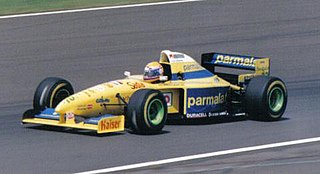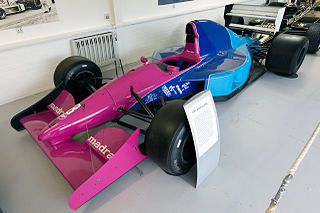
Formula Two is a type of open-wheel formula racing category first codified in 1948. It was replaced in 1985 by Formula 3000, but revived by the FIA from 2009–2012 in the form of the FIA Formula Two Championship. The name returned again in 2017 when the former GP2 Series became known as the FIA Formula 2 Championship.
Ian Gordon Murray, is a South African-British designer of Formula One racing cars for Brabham and McLaren and the McLaren F1 high-performance road car. Founder and CEO of Gordon Murray Design and Gordon Murray Automotive, he has subsequently designed and built a number of sports cars and a variety of other automotive vehicles.

Peter Paul Sauber is a retired Swiss motorsport executive. He was the team principal and owner of various motorsports teams, most visibly the eponymous Sauber Formula One team.

Simtek was an engineering consultancy firm and Formula One racing team. The Formula One (F1) engineering consultancy arm, Simtek Research, was founded in 1989 by Max Mosley and Nick Wirth. It originally was involved in many areas of Formula One, including wind tunnel construction and chassis building for third parties. Simtek Grand Prix, the racing team, was launched in 1993 and competed in the 1994 and 1995 seasons, achieving a best result of ninth place. With large debts and a lack of sponsorship money, Simtek went into voluntary liquidation in June 1995.
Fondmetal S.p.A. is an Italian manufacturer of alloy wheels, founded in 1972 by Gabriele Rumi.

Forti Corse, commonly known as Forti, was an Italian motor racing team chiefly known for its brief and unsuccessful involvement in Formula One in the mid-1990s. It was established in the late 1970s and competed in lower formulae for two decades. The team's successes during this period included four Drivers' Championships in Italian Formula Three during the 1980s, and race wins in the International Formula 3000 championship, in which it competed from 1987 to 1994. From 1992, team co-founder Guido Forti developed a relationship with the wealthy Brazilian businessman Abílio dos Santos Diniz that gave Diniz's racing driver son, Pedro, a permanent seat in the team and the outfit a sufficiently high budget to consider entering Formula One.
March Engineering was a Formula One constructor and manufacturer of customer racing cars from the United Kingdom. Although only moderately successful in Grand Prix competition, March racing cars enjoyed much better success in other categories of competition, including Formula Two, Formula Three, IndyCar and IMSA GTP sportscar racing.

Team Lotus was the motorsport sister company of English sports car manufacturer Lotus Cars. The team ran cars in many motorsport categories including Formula One, Formula Two, Formula Ford, Formula Junior, IndyCar, and sports car racing. More than ten years after its last race, Team Lotus remained one of the most successful racing teams of all time, winning seven Formula One Constructors' titles, six Drivers' Championships, and the Indianapolis 500 in the United States between 1962 and 1978. Under the direction of founder and chief designer Colin Chapman, Lotus was responsible for many innovative and experimental developments in critical motorsport, in both technical and commercial arenas.
Jörg Zander is a German Formula One car designer.

Ricardo Ramsey "Richard" Divila was a Brazilian motorsports designer. He worked in Formula One, Formula Two, Formula Three, Formula 3000, Super Formula, IndyCar, touring car racing, sports car racing, rallying, rally raid, ice racing, truck racing, among other disciplines.
In car design, ground effect is a series of effects which have been exploited in automotive aerodynamics to create downforce, particularly in racing cars. This has been the successor to the earlier dominant aerodynamic focus on streamlining. The international Formula One series and American racing IndyCars employ ground effects in their engineering and designs. Similarly, they are also employed in other racing series to some extent; however, across Europe, many series employ regulations to limit its effectiveness on safety grounds.

The Forti FG01, also designated Forti FG01-95, was a Formula One car for the 1995 season and was the first car made by Forti. The number 21 seat was taken by rookie Pedro Diniz and the number 22 seat was taken by veteran Roberto Moreno. The team never employed a test driver. The engine was a Ford EDD 3.0 V8. The team's main sponsor was Parmalat. The FG01 is also notably the last F1 car to sport a conventional manual gearbox + H-pattern shifter, and was the only car to use one on the grid.
Gary Anderson is a Northern Irish semi-retired racing car designer and motorsport pundit/commentator.
John Judd is a Formula One engineer from England. He is the boss of Engine Developments Ltd., manufacturers of Judd engines. He is also known for his partnership with triple F1 World Champion Sir Jack Brabham.

Enrique Hector Scalabroni is an Argentinian race car designer, technical director, and team racing boss. He was employed by Dallara, Williams, Ferrari, Lotus and Peugeot Sport between 1985 and 2002, before setting up his own F3000 and GP2 team in 2003, BCN Competicion, which lasted till the end of 2008.

The Brabham BT60 was the final series of Formula One racing cars built for the Brabham Formula One motor racing team. Designed by Sergio Rinland, they raced in the 1991 and 1992 Formula One World Championships. The car brought to a close Brabham's 30 years of construction of purpose-built racing cars, which began with Jack Brabham and Ron Tauranac and the Brabham BT1 Formula Junior design in 1961.
Jacques "Jacky" Eeckelaert is a Belgian automotive engineer who has worked in many categories of motorsport. He currently works for Abt Sportsline as Technical Director in the DTM.
The Fondmetal GR02 was a Formula One racing car designed by Sergio Rinland and his Astauto studio for the 1992 Formula One season. Built to replace the Fondmetal GR01, as Fondmetal's team boss Gabriele Rumi had never been impressed by that car or its predecessor, the Fomet-1, the GR02 used the same 3.5-litre Ford HBA5 V8 engine as its predecessor. Gabriele Tarquini gave the GR02 its début at the 1992 Canadian Grand Prix, whilst team mate Andrea Chiesa first drove it in the following 1992 French Grand Prix. Although the GR02 showed promise, and drew praise from the media, Fondmetal's financial difficulties meant that they withdrew from Formula One after the 1992 Italian Grand Prix.
Bowman Automotive is a former racecar constructor and current racing kart producer. Bowman produced cars for Formula Ford, Formula 3, USF2000 and other racing series.

The 2018 FIA Formula 2 Championship was the fifty-second season of the second-tier of Formula One feeder championship and also second season under the moniker of FIA Formula 2 Championship, a motor racing championship for Formula 2 cars that is sanctioned by the Fédération Internationale de l'Automobile (FIA). It is an open-wheel racing category that serves as the second tier of formula racing in the FIA Global Pathway. The category run in support of the 2018 FIA Formula One World Championship, with each of the twelve rounds running in conjunction with a Grand Prix. It was the first FIA Formula 2 season to feature a new chassis and engine package.










